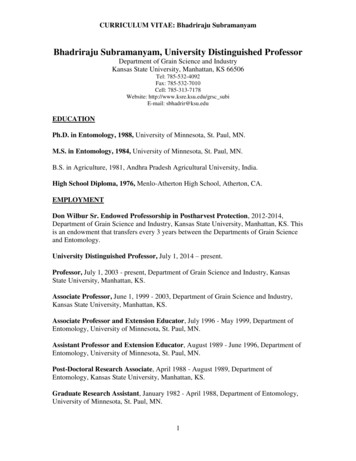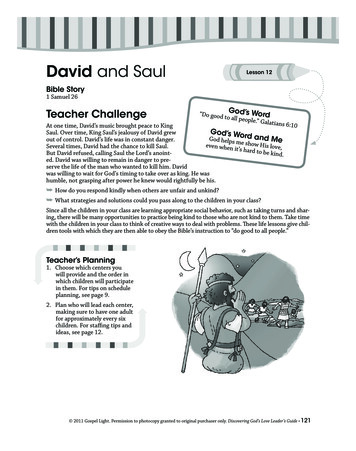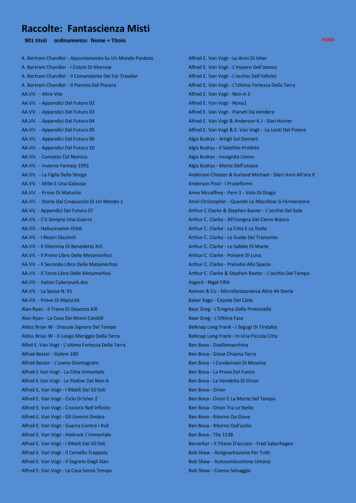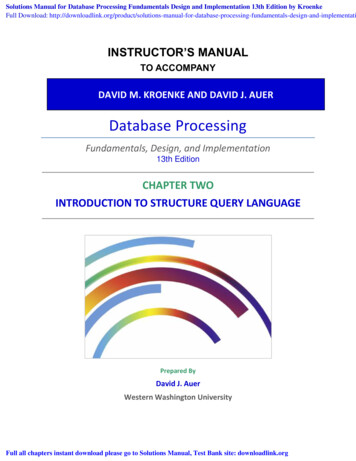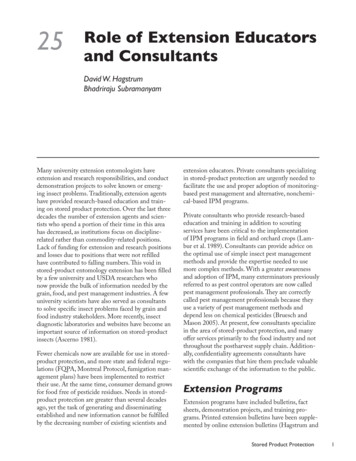
Transcription
25Role of Extension Educatorsand ConsultantsDavid W. HagstrumBhadriraju SubramanyamMany university extension entomologists haveextension and research responsibilities, and conductdemonstration projects to solve known or emerging insect problems. Traditionally, extension agentshave provided research-based education and training on stored product protection. Over the last threedecades the number of extension agents and scientists who spend a portion of their time in this areahas decreased, as institutions focus on disciplinerelated rather than commodity-related positions.Lack of funding for extension and research positionsand losses due to positions that were not refilledhave contributed to falling numbers. This void instored-product entomology extension has been filledby a few university and USDA researchers whonow provide the bulk of information needed by thegrain, food, and pest management industries. A fewuniversity scientists have also served as consultantsto solve specific insect problems faced by grain andfood industry stakeholders. More recently, insectdiagnostic laboratories and websites have become animportant source of information on stored-productinsects (Ascerno 1981).Fewer chemicals now are available for use in storedproduct protection, and more state and federal regulations (FQPA, Montreal Protocol, fumigation management plans) have been implemented to restricttheir use. At the same time, consumer demand growsfor food free of pesticide residues. Needs in storedproduct protection are greater than several decadesago, yet the task of generating and disseminatingestablished and new information cannot be fulfilledby the decreasing number of existing scientists andextension educators. Private consultants specializingin stored-product protection are urgently needed tofacilitate the use and proper adoption of monitoringbased pest management and alternative, nonchemical-based IPM programs.Private consultants who provide research-basededucation and training in addition to scoutingservices have been critical to the implementationof IPM programs in field and orchard crops (Lambur et al. 1989). Consultants can provide advice onthe optimal use of simple insect pest managementmethods and provide the expertise needed to usemore complex methods. With a greater awarenessand adoption of IPM, many exterminators previouslyreferred to as pest control operators are now calledpest management professionals. They are correctlycalled pest management professionals because theyuse a variety of pest management methods anddepend less on chemical pesticides (Bruesch andMason 2005). At present, few consultants specializein the area of stored-product protection, and manyoffer services primarily to the food industry and notthroughout the postharvest supply chain. Additionally, confidentiality agreements consultants havewith the companies that hire them preclude valuablescientific exchange of the information to the public.Extension ProgramsExtension programs have included bulletins, factsheets, demonstration projects, and training programs. Printed extension bulletins have been supplemented by online extension bulletins (Hagstrum andStored Product Protection1
Part IV Management: Decision MakingSubramanyam 2009a) that can be updated more easily (VanDyk 2000). For example, in Kansas, the valueof probe traps for monitoring insect populations instored wheat and deciding whether pest management intervention is needed was first demonstratedwith cooperating producers (Lippert and Hagstrum1987). Harein and Clarke (1995) provided a list oftraining programs that have been offered consistentlyin the “train-the-trainer” format for university extension entomologists and state Department of Agriculture representatives responsible for stored-productprotection.The online extension bulletins and fact sheets typically provide information on insect biology andmanagement with emphasis on insecticides currentlyregistered for use. This creates an opportunity forconsultants to replace researchers and extension educators, working closely with producers, grain elevatormanagers, food industry sanitarians, and pest management professionals to provide customized management solutions.The earmarked funding for extension programsof several decades ago is no longer available, andextension effort has now become part of integratedprojects supported by federal agencies on a competitive basis. Competitive grants now are required to bemulti-authored, multi-institutional, and multi-yearprojects with outcomes that are widely applicableand implementable. The lack of people working inthis area makes it difficult to get consistent funding for federal projects that require large workinggroups. Consultants have a great potential to enterthe stored-product protection arena and to collaborate with university and USDA scientists on fundingopportunities, in addition to filling the void createdby the loss of extension personnel and services.Scouting ProgramsInternational trade has increased the likelihood ofuncommon insect species being found (Hagstrumand Subramanyam 2009b). More than 1,663 insectspecies have been associated with stored products,making identification difficult. Monitoring and treating only when insects are detected can eliminateunnecessary sprays or fumigations (Mabbett 1995).Timing of pest management is critical and requiresinsect monitoring (Subramanyam 2007). Understanding the problem often involves detective work.2K-State Research and ExtensionSelection of an optimal pest management methodmay depend on which insect species are present.During World War II, when Canada could not shipgrain, a scouting program was developed to monitor long-term flat storages (Smallman 1944). InKentucky, a pilot grain-scouting program for insectand moisture problems was started with 15 producers in one county in 1978, and then expanded to sixcounties (Skinner 1982). Producers paid from 1 to 5cents per bushel for the scouting service. As a resulta number of serious problems were prevented. Thiswas an extension initiative, but this program wasunable to be sustained beyond the time limits of theresearch program. These scouting programs requiretrained staff and timely help, which consultants canprovide. Generally, extension educators and countyextension staff are responsible for several areas ofexpertise other than stored product protection. Manystates do not have an extension specialist in thearea of stored product entomology. Questions aredeferred to researchers working in stored productentomology or pest management professionals.Diagnostic LaboratoriesIdentification of insects to species is the first step ineffective pest management (Hagstrum and Subramanyam 2006). Species identification is necessaryif published information on biology, ecology, andbehavior is to be used in designing a pest management program. Also, the type and amount of damagethe insects cause varies among species. The methodsused for monitoring various species and the developmental stage most vulnerable to pest managementprograms also differ among insect species. For abroad-spectrum chemical pesticide, the susceptibilityof insects to the pesticide and the choice of the bestapplication method are likely to vary with species aswell. Diagnostic laboratories in at least 11 states havedealt extensively with stored product insects (Table1). In most cases, identification services are primarilyfor state residents, but at least four states will identifyinsects for nonresidents. These diagnostic laboratories are supported by tax dollars or have a mechanism for cost recovery through fees for services.In Minnesota, from 1976 to 1979, the sawtoothedgrain beetle was the third to fifth most frequentproblem in homes handled by the diagnostic laboratory (Ascerno 1981). The number of inquiries aboutthe sawtoothed grain beetle increased through the
Chapter 25 Role of Extension Educators and ConsultantsTable 1. Diagnostic laboratories that provide stored-product insect identification servicesa.http://edis.ifas.ufl.edu/sr010Lyle BussBldg. 970, Natural Area Dr.PO BOX 110620University of FloridaGainesville, FL 32611-0620Phone: 352-273-3933Fax: .edu/The C. Wayne Ellett Plant and Pest Diagnostic ClinicThe Ohio State University110 Kottman Hall2021 Coffey RoadColumbus, OH 43210-1087Phone: 614-292-5006Fax: //www.ppdl.purdue.edu/ppdl/services.htmlPlant and Pest Diagnostic LaboratoryLSPS-Room 101Purdue University915 W. State StreetWest Lafayette IN 47907-2054Phone: 765-494-7071Fax: .edu/plantclinicClemson University Plant Problem Clinic511 Westinghouse RoadPendleton, SC 29670Phone: 864-646-2133Fax: y.ksu.edu/DesktopDefault.aspx?tabid 49Holly Davisgotbugs@ksu.eduDepartment of Entomology123 West Waters HallManhattan, KS 66506Phone: 785-532-4739http://utahpests.usu.edu/uppdl/Utah Plant Pest Diagnostic LabDept. of BiologyUtah State University5305 Old Main HillLogan, UT 84322-5305Phone: 435-797-2435Fax: .htmClay Kirby, Insect DiagnosticianUniversity of Maine Cooperative ExtensionPest Management Office491 College AvenueOrono, ME 04473-1291-800-287-0279 in Maine or 207-581-2963Fax: .ento.vt.edu/Eric R. Day, ManagerInsect Identification LaboratoryDepartment of EntomologyVirginia TechBlacksburg, VA logy/extension/idl/index.cfmInsect Diagnostic LaboratoryDept. of Entomology4140 Comstock HallIthaca, NY .wvu.edu/pests/identificationPest Identification LaboratoryWest Virginia Department of Agriculture1900 Kanawha Blvd. EastCharleston, WV 25305-0191Phone: h-staff-profilephil-pellitteriInsect Diagnostic Lab240 Russell Labs1630 Linden DriveMadison, WI 53706aLabs in Florida, Indiana, Ohio, and South Carolina identify insects for nonresidents.Stored Product Protection3
Part IV Management: Decision Makingsummer and then declined, perhaps as a result ofcooler fall and winter temperatures (Figure 1). Aprivate diagnostic laboratory in Kansas (www.alteca.com) sells insects to food-processing companies inspecially designed cards to be placed throughout thefacility to monitor effectiveness of fogging, fumigation, or heat treatment. They also provide technicaltraining on insect identification and other microanalytical entomology services such as identificationof insect fragments in grain and processed food.Diagnostic laboratories will continue to be importantas consultants become active in the postharvest area.Research ProgramsResearchers often conduct applied research andtransfer this technology directly to the end-users.For example, a cowpea warehouse manager in Florida could stand in the doorway of her warehouse inthe spring and hear cowpea weevils moving aroundinside the paper bags in which the cowpeas had beenstored the previous fall after being harvested anddried. She wanted to know how the cowpea weevilsgot into the bags. By sampling cowpeas as they wereharvested, researchers found that small numbers ofcowpea weevils were infesting the cowpeas in the180Reed and Harner (1998) demonstrated to farmersthe value of aeration controllers in protecting storedgrain. Both the farmers and extension agents weremade an integral part of this learning experience.After the demonstration project ended, farmers continued to use the aeration controllers.Curtis (1984) showed that navel orangeworms laideggs on almonds remaining in the trees after harvest,but did not lay eggs on almonds that had fallen to theground. Johnson et al. (2002) showed that combining an initial disinfestation treatment with one ofthree protective treatments — cold storage (10 C),controlled atmosphere (5% oxygen) storage, or application of the Indianmeal moth granulosis virus —was an effective alternative to chemical fumigationof almonds and raisins for suppression of Indianmealmoth and navel orangeworm populations. Soderstrom et al. (1987), using a sex pheromone that1976197719781979160140Number of requestsfields and reproducing in the bags. Offspring slowlydeveloped through the cool winters and emergedfrom the cowpeas in large numbers in the spring(Hagstrum 1985). Johnson and Valero (2003) determined that organic garbanzo beans needed to be in afreezer for only 14 days to eliminate cowpea nJulAugSepOctNovMonthFigure 1. Sawtoothed grain beetle infestation inquiries (redrawn and used with permission from Ascerno 1981).4K-State Research and ExtensionDec
Chapter 25 Role of Extension Educators and Consultantsattracts five species of stored product moths, showedthe species captured differed among raisin packingplants in the United States, shipping containers, andEuropean warehouses.Locating and eliminating source populations canbe one of the least expensive and most productivecomponents of an IPM program. Vick et al. (1986)used pheromone traps to show the moth problemsin grocery distribution warehouses were associatedwith birdseed and chicken feed. Platt et al. (1998)found stored-product insects most frequently in theflour and pet food aisles of grocery stores. Bowditchand Madden (1996) found that moths were abundant in only 3 of 35 rooms of a confectionary factory.These rooms were used for chocolate refining andnut roasting, and high captures were near infestedmachinery or a result of insects being attracted towater that was present.At Kansas State University, a total of six heat treatment workshops were held to train food industrystaff about the use of elevated temperatures (50to 60 C for 24 to 36 hours) for disinfesting foodprocessing facilities. A total of 350 participants fromthe U.S. and other parts of the world attended theseworkshops. During the workshops, the pilot flourand feed mills at Kansas State University were heattreated with gas and electric heaters, so that participants were part of practical heat treatments, from thebeginning to the end.Research by Kansas State University scientists onthe maximum time required to kill adults and theheat-tolerant young larvae of the red flour beetle(Mahroof et al. 2003) showed that these two insectstages were killed 12 hours into the heat treatment.Based on these data, a breakfast cereal manufacturerreduced total heat treatment time to 24 hours, resulting in an annual cost savings of 25,000 (Subramanyam 2010). The cost-effectiveness prompted thiscompany to use heat treatments in their other processing facilities to replace fumigations, which wouldrequire sealing the facility and stopping productionuntil the air is safe for workers to continue work.These consultants often are active faculty membersat a university, or retired government, food industry,and university personnel. In some cases, companies hire consultants to provide services as expertwitnesses in legal cases. Consultants are valuablebecause they have knowledge and access to scientificand popular literature (Hagstrum and Subramanyam2009a) plus relevant practical experiences.A private consulting company, Precision GrainManagement (http://www.grainstoragescience.com),founded and run by an emeritus university facultymember, now provides scouting services. As the onlyone doing this type of work, the company advisedmore than 70 elevators in Kansas, Oklahoma andNebraska from 2003 to 2010 (Hagstrum et al. 2010).The sampling program has improved insect pestmanagement by ensuring that fumigation is donewhen it is most cost-effective. For example, PrecisionGrain Management personnel sampled insect populations in 25 flat storages of corn or wheat at elevators in Kansas 116 times between 2003 and 2009, bytaking a total of 16,549 grain samples (Hagstrum etal. 2010). The samples were often taken after aeration and fumigation to assure elevator managers thatpest management efforts had been effective. Insectswere not found in 20 of the flat storages. Insectpopulations in the grain in the other five flat storagesgenerally did not reach densities that would resultin an infested designation on the grain-gradingcertificate.Adoption of New MethodsConsultantsExtension educators and consultants can encourageadoption of new technologies. Automation of monitoring for insects in grain using acoustical methods,methods of converting trap catch to absolute estimates, models predicting insect population growthrates, and more accurate economic thresholds andcost/benefit analysis can improve pest management.Attracticide (lure-and-kill), mass-trapping, andbiological control may be useful in some situations.These methods have potential and are being morewidely tested and adopted by the grain and foodindustry. The use of biological control is reviewed inChapter 17 of this book.Consultants are routinely used in the grain and foodprocessing industry as a second, unbiased, pair ofeyes and a means of keeping up with new pest management methods and regulations (Gerberg 1991).Acoustical methods are commercially available forautomatic continuous, non-destructive, remote monitoring of insect populations in stored grain (Mankinet al. 2010 and Chapter 22 of this book), but they areStored Product Protection5
Part IV Management: Decision Makingnot widely used. Probe traps for automatic, continuous, non-destructive, remote monitoring insects ingrain also are being marketed (Flinn et al. 2009), butare not widely used. Methods have been developedfor converting these trap catches (Flinn et al. 2009)and those for sticky traps to absolute insect densities(Savoldelli 2006). Many of the tools and techniqueshave not been adopted because of lack of understanding and risk-averse behavior to newer technologies that deviate from traditional methods.The decision tools developed for IPM in field andorchard crops have not been widely adopted for theprotection of stored products. Sampling-based decision-making is being emphasized, but few economicthresholds have been developed for stored-productpests. The economic threshold is specific for a givenspecies, and is the insect density at which pest management must be applied to prevent economic losses,but below which pest management is not economical (Onstad 1987). The thresholds depend on cost ofthe pest management method and market value ofthe commodity being protected. Multiple thresholdsneed to be considered if more than one pest management method is available, and the threshold mustbe adjusted as cost of pest management methods orthe market values of the stored commodities change.Also, insect population growth models can be useful in predicting future insect densities, preventable commodity damage, and economic losses. Thepopulation growth models that have been developedfor stored-product insects are listed in Table 7.3 inHagstrum and Subramanyam (2006). The modelscan be used to determine when the economic threshold will be reached.Pheromones and food attractants have been investigated as means of increasing the effectiveness ofspot insecticide treatments for the Indianmeal moth(Nansen and Phillips 2004) and navel orangeworm(Phelan and Baker 1987). A Hawaii company (FoodProtection Services) has conducted long-termstudies on the use of mass trapping to find sourcepopulations and reduce cigarette beetle and mothpopulations in food storage warehouses and bakeries (Pierce 1994,1999). Similar studies were donesuccessfully in a flour mill in Italy (Trematerra andGentile 2010).6K-State Research and ExtensionFollow-Up MonitoringMonitoring is critical to determining whether theinstituted pest management was effective. Roesli etal. (2003) used traps for stored-product beetles andmoths to gauge the effectiveness of heat treatmentin a feed mill. Some species — such as the cigarettebeetle, Indianmeal moth, and almond moth — werecompletely controlled by the heat treatment, andvery few insects were captured during the postheat treatment period, whereas populations of thered flour beetle were captured within two to fourweeks. Pest management professionals offering IPMservices should monitor insect populations to showclients the degree and duration of insect management obtained due to an IPM intervention.Mason (2005) suggested that the use of follow-upinsect monitoring is an important consideration inselecting a fumigator. Using 15 published studies,Hagstrum and Subramayam (2006, see Table 8.1)showed that pest management was often ineffective.The ineffectiveness of pest management in the studies was a result of the breakdown of insecticides overtime, inadequate sealing of facilities before fumigation, insects becoming resistant to pesticides, damageto insect-resistant packaging, diapause, and refugesin which insects could avoid being removed or killed.These studies covered many locations in the marketing system, ranging from the farm to the retailstore. Pest management methods included the use ofinsecticides as protectants, fumigation, fogging withaerosols, sanitation, and insect-resistant packaging.Effectiveness can be influenced by the age structureof the pest population, insect species composition,environmental conditions, improper selection andincorrect implementation of pest management,including the absence of quantitative insect-monitoring methods.The landscape of stored-product protection in the21st century is changing and will continue to evolve,with IPM shifting from chemical methods to methods that are environmentally benign. The shrinkingnumber of stored-product protection centers worldwide, and the decreasing number of researchers andeducators offers great opportunities for consultantsto embrace this area, as they have with field crops,and to develop and implement customized programsfor the grain and food industry stakeholders. Thenew knowledge that the consultants can generate instored-product protection and the role they can play
Chapter 25 Role of Extension Educators and Consultantsto meet the needs of the end-users for the foreseeable future is immense.Lambur, M.T., R.E. Kazmierczak Jr., and E.G. Rajotte. 1989.Analysis of private consulting firms. Bull. Entomol. Soc.Amer. 35: 5-11.ReferencesLippert, G.E., and Hagstrum, D.W. 1987. Detection or estimation of insect populations in bulk‑stored wheat with probetraps. J. Econ. Entomol. 80: 601‑604.Ascerno, M.E. 1981. Diagnostic clinics: more than a publicservice. Bull. Entomol. Soc. Amer. 27: 97-101.Bowditch, T.G., and J.L. Madden. 1996. Spatial and temporaldistribution of Ephestia cautella (Walker) (Lepidoptera:Pyralidae) in a confectionary factory: causal factors andmanagement implications. J. Stored Prod. Res. 32: 123-130.Bruesch, J., and L. Mason. 2005. Role of the pest managementprofessional in food-processing pest management. pp11-18. In Jerry Heaps (ed.), Insect Management for FoodStorage and Processing, Second Edition, AACC International, St. Paul, MN.Curtis, C.E., R.K. Curtis, and K.L. Andrews. 1984. Progressionof navel orangeworm (Lepidoptera: Pyralidae) infestationand damage of almonds on the ground and on the tree during harvest. Environ. Entomol. 13: 146-149.Flinn, P.W., G.P. Opit, and J.E. Throne. 2009. Predicting storedgrain insect population densities using an electronic probetrap. J. Econ. Entomol. 102: 1696-1704.Gerberg, E.J. 1991. Professional and consultant services. p.549-550. In Gorham, J. R. (ed.), Ecology and Managementof Food‑Industry Pests. Food and Drug AdministrationTechnical Bulletin 4, Association of Official AnalyticalChemists, Arlington, Virginia.Hagstrum, D.W. 1985. Preharvest infestation of cowpeas bythe cowpea weevil, Callosobruchus maculatus (Coleoptera:Bruchidae) and population trends during storage in Florida.J. Econ. Entomol. 78: 358-361.Hagstrum, D.W., and Bh. Subramanyam. 2006. Fundamentalsof Stored-Product Entomology. AACC International, St.Paul, Minnesota.Hagstrum, D.W., and Bh. Subramanyam. 2009a. A review ofstored-product entomology information sources. Amer.Entomol. 55: 174-183.Hagstrum, D.W., and Bh. Subramanyam. 2009b. Stored-ProductInsect Resource. AACC International, St. Paul, Minnesota.Hagstrum, D.W., P.W. Flinn, C.R. Reed and T.W. Phillips.2010. Ecology and IPM of insects at grain elevators andflat storages. Biopestic. Intern. 6: 1-20.Harein, P.K. and S.A. Clarke. 1995. Technology transfer inmanagement of stored grain pests. pp. 661-675. In D. S.Jayas, N. D. G. White, and W. E. Muir (eds.), Stored-grainEcosystems, Marcel Dekker, NY.Johnson, J.A., P.V. Vail, G. Brandl, J.S. Tebbets, and K.A. Valero.2002. Integration of nonchemical treatments for controlof postharvest pyralid moths (Lepidoptera: Pyralidae) inalmonds and raisins. J. Econ. Entomol. 95: 190-199.Johnson, J.A., and K.A. Valero. 2003. Use of commercial freezersto control cowpea weevil, Callosobruchus maculatus (Coleoptera: Bruchidae), in organic garbanzo beans. J. Econ.Entomol. 96: 1952-1957.Mabbett, T. 1995. Pheromone traps reduce insurance fumigationfor cocoa bean pests. International Pest Control. 37: 73-74.Mahroof, R., Bh. Subramanyam, J.E. Throne, and A. Menon.2003. Time-mortality relationships for Tribolium castaneum(Herbst) life stages exposed to elevated temperatures. J.Econ. Entomol. 96: 1345-1351.Mankin, R.W., D.W. Hagstrum, M.T. Smith, A.L. Roda, andM.T.K. Kairo. 2011. Perspective and promise: a century ofinsect acoustic detection and monitoring. Amer. Entomol.57: 30-44.Mason, L. 2005. Hiring a fumigator: six items to consider whenhiring an outside contractor for fumigations. Grain JournalJuly/August pp. 56-58.Nansen, C., and T.W. Phillips. 2004. Attractancy and toxicity ofan attracticide for Indianmeal moth, Plodia interpunctella(Lepidoptera: Pyralidae). J. Econ. Entomol. 97: 703-710.Phelan, P.L., and T.C. Baker. 1987. An attracticide for control ofAmyelois transitella (Lepidoptera: Pyralidae) in almonds. J.Econ. Entomol. 80: 779-783.Pierce, L.H. 1994. Using pheromones for location and suppression of phycitid moths and cigarette beetles in Hawaii—Afive-year summary, pp. 439-443. In Highley, E., E.J. Wright,H.J. Banks, and B.R. Champ (eds.), Proceedings of theInternational Working Conference on Stored Product Protection, York, 22-26 July 2002, sixth edition, CAB International, Wallingford, UK.Pierce, L.H. 1999. Suppression of cigarette beetles, Lasiodermaserricorne (Fabricius) by focused mass trapping, pp. 14551463. In Zuzan, J., L. Quan, L. Yongsheng, T. Xiachang,and G. Liaghua, (eds.), Proceedings of the InternationalWorking Conference on Stored Product Protection, Beijing,14-19 October 1998, seventh edition, Sichuan PublishingHouse, Chengdu, Peoples Republic of China.Platt, R.R., Cuperus, G.W., Payton, M.E., Bonjour, E.L.,Pinkston, K.N. 1998. Integrated pest management perceptions and practices and insect populations in grocery storesin south-central United States. J. Stored Prod. Res. 34:1-10.Reed, C., and J. Harner. 1998. Thermostatically controlledaeration for insect control in stored hard red winter wheat.Appl. Eng. Agric. 14: 501-505.Roesli, R., Bh. Subramanyam, F.J. Fairchild, and K.C. Behnke.2003. Trap catches of stored product insects before andafter heat treatment in a pilot feed mill. J. Stored Prod. Res.39: 521-540.Savoldelli, S. 2006. Correlation between Plodia interpunctellaHübner (Lepidoptera, Pyralidae) males captured with wingtrap and the real density of moth’s population, pp. 487491. In Lorini, I., B. Bacaltchuk, H. Beckel, D. Deckers, E.Sundfeld, J.P. dos Santos, J. D. Biagi, J. C. Celaro, L.R.D’aFaroni, L. de O.F. Bortolini, M.R. Sartori, M.C., Elias, R.Stored Product Protection7
Part IV Management: Decision MakingN.C. Guedes, R.G. da Fonseca, and V.M. Scussel. (eds),Proceedings of the 9th International Working Conferenceon Stored Product Protection, 15 – 18 October 2006, Brazilian Post-harvest Association, Campinas, Brazil.Skinner, M. 1982. Farmers scout stored grain investment. Extension Rev., Spring: 4-6.Smallman, B.N. 1944. Solving the infestation hazard of Canada’swar-grain storage. Amer. Miller and Processor 72: 37–39,50–51.Soderstrom, E.L., R.T. Hinsch, A.J. Bongers, D.G. Brandl,and H. Hoogendorn. 1987. Detecting adult Phycitinae(Lepidoptera: Pyralidae) infestations in a raisin-marketingchannel. J. Econ. Entomol. 80: 1229-1232.Subramanyam, Bh. 2007. Pest management timing. MillingJournal, First Quarter pp. 38-39.VanDyk, J.K. 2000. Impact of the internet on extension entomology. Ann. Rev. Entomol. 45: 795-802.Trematerra, P. and P. Gentile. 2010. Five years of mass trappingof Ephestia kuehniella Zeller: a component of IPM in a flourmill. J. Appl. Entomol. 134: 149-156.Vick, K.W., P.G. Koehler, and J.J. Neal. 1986. Incidence ofstored-product Phycitinae moth in food distribution warehouses as determined by sex pheromone-baited traps.J. Econ. Entomol. 79: 936-939.Subramanyam, Bh. 2010. Optimizing heat treatments formanagement of stored-product insects in food-processingfacilities, pp. 948-949. In Carvalho, M. O., P. G. Fields, C.S. Adler, F. H. Arthur, C. G. Athanassiou, J. F. Campbell, F.Fleurat-Lessard, P.W. Flinn, R.J. Hodges, A.A. Isikber, S.Navarro, R.T. Noyes, J. Riudavets, K.K. Sinha, G.R. Thorpe,Brand names appearing in this publication are for productidentification purposes only. No endorsement is intended, nor iscriticism implied of similar products not mentioned.Publications from Kansas State University are available at: www.ksre.ksu.eduKansas State University Agricultural Experiment Station and CooperativeExtension ServiceK-State Research and Extension is an equal opportunity provider and employer.Issued in furtherance of Cooperative Extension Work, Acts of May 8 and June30, 1914, as amended. Kansas State University, County Extension Councils,Extension Districts, and United States Department of Agriculture Cooperating,Gary Pierzynski, Interim Director.S156 – 25 December 2011Publicati
facilitate the use and proper adoption of monitoring-based pest management and alternative, nonchemi- . projects supported by federal agencies on a competi-tive basis. Competitive grants now are required to be multi-authored, multi-institutional, and multi-year . Gainesville, FL 32611-0620 Phone: 352-273-3933 Fax: 352-392-5660 ufinsectid .
![No, David! (David Books [Shannon]) E Book](/img/65/no-20david-20david-20books-20shannon-20e-20book.jpg)
